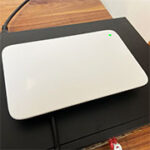The Meraki Go GR12 marks the manufacturer’s entrance into the WiFi 6 access points market and, while a bit later than the other players, just like Ubiquiti, it didn’t really care that much about competition and took its time to offer a potentially better product.
| Meraki Go GR12 | |
|---|---|
| Meraki-go.com | Check Product |
| Amazon.com | Check Offer |
If you’re not familiar with the brand, know that the Meraki Go line was developed as a way for Cisco to have some presence into SMB and home-based networking market. For this reason, the software has been tuned in a manner as to accommodate people that are not tech-savvy and I know that it’s a bit strange coming from Cisco, but that’s the vision that the developers saw fit to implement.
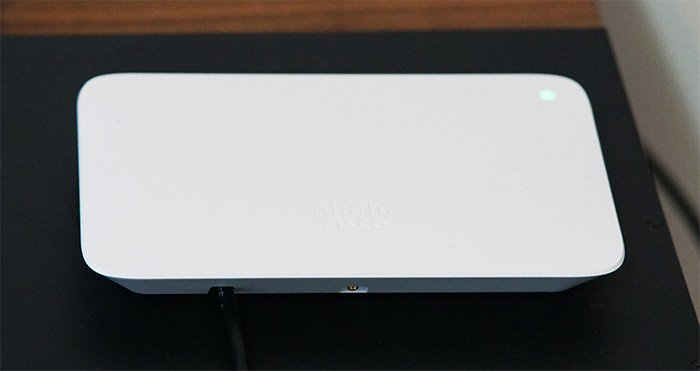
Even so, the user does get a web portal management platform, as well as a Cloud-managed mobile app to monitor and configure the network. Furthermore, the Meraki Go GR12 does offer the main WiFi 6 features which includes OFDMA and I also saw the support for TWT and BSS coloring which is usually left out from the cheaper AP models. Additionally, the Meraki Go GR12 does have support for meshing, allowing the creation of a larger network where the user can fast roam from AP to AP (PMK and OKC), but the channel bandwidth only goes up to 80MHz (the 160MHz can be difficult to use in a crowded environment anyway).
Also, the PoE port is Gigabit, which is fine considering the targeted audience. That being said, let’s put the Meraki Go GR12 to the test and see how well it performs and how it compares to its main competitors.
Design and Build Quality
For the first batch of WiFi 6 access points, the manufacturers cared more about the tech than the size, so we did get huge APs, such as the WAX650S or the EAP660 HD. But, over the last year, I did see a noticeable shrinking in size and considering that the Meraki Go GR12 was recently released, the case is very compact. Indeed, at 7.95 x 5.55 x 1.02 inches (20.2 x 14.1 x 2.6 cm), the Meraki Go GR12 is one of the smaller WiFi 6 access points on the market and I did like that the manufacturer made the device rectangular, instead of the usual circular shape.
That’s because the Meraki Go GR12 is not a ceiling-mount-only access point – it can be installed on the ceiling, but the developers made sure to include a couple of mounting holes for attaching the device on the wall as well. Plus, there are four silicone feet, so it’s also very possible to just leave the access point on the desk. Now let’s talk about the thermal management.
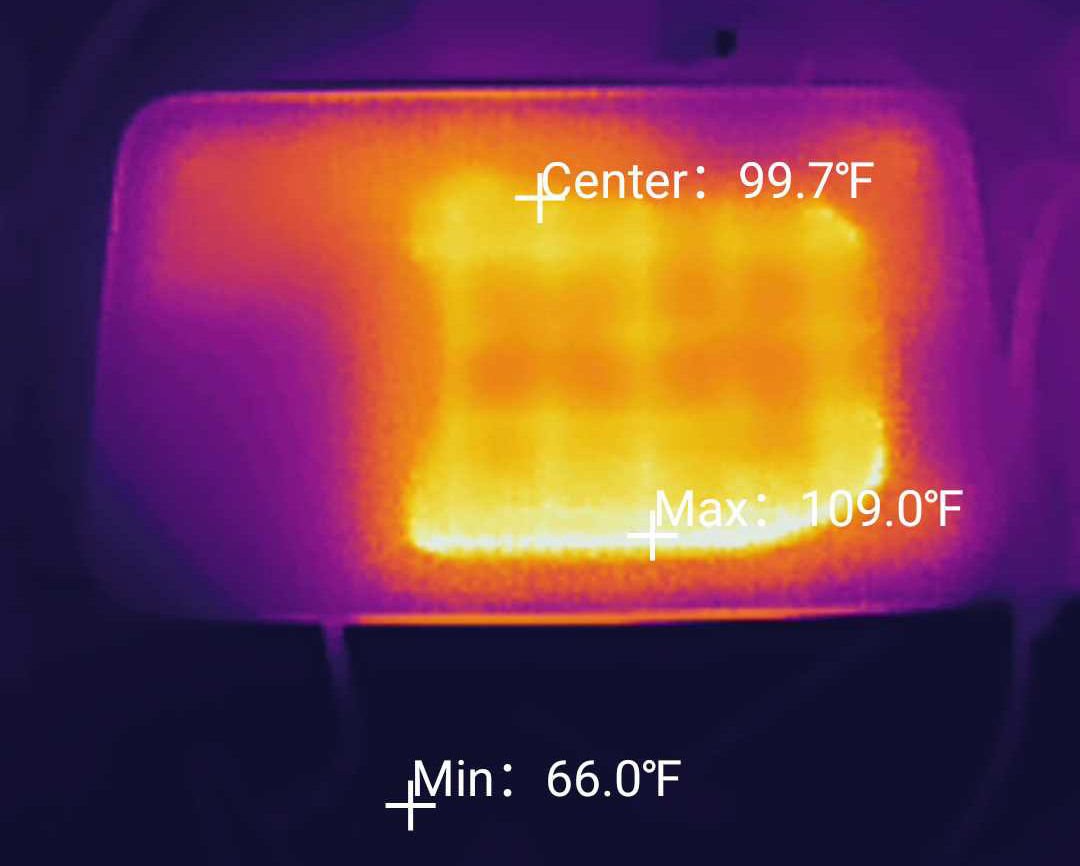
Some manufacturers have decided to use the metallic bottom part of the case to guide the heat outwards, but the Meraki Go GR12 is all plastic, so they went with a different approach, right? Kind of because after opening up the case, I did see that there was a metallic piece which had the role of dispersing the heat away from the main chipsets. This way, the case remains warm and doesn’t get hot to the touch. I did check how hot the device can get and as you can see from the thermal photo, it’s acceptable.
The WiFi 6 access point relies on a single LED to tell the status of the network and connection. If this LED is solid orange, then there is a hardware issue (it will also be orange while the AP is booting up), otherwise, if it’s green, then there are no connected clients and, as soon as some WiFi devices do connect, the LED will become solid blue.
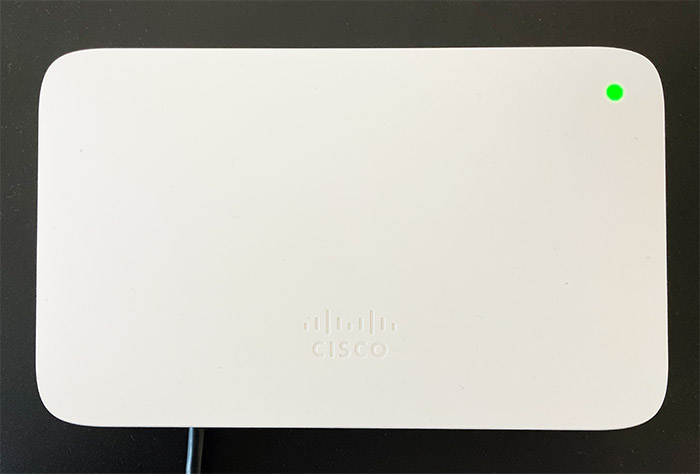
I suppose I also need to mention the rainbow LED when the AP is initializing. Looking around the case, there are no ventilation holes and just at the bottom, there is a recessed area for the Ethernet port which does support PoE (802.3af) and it’s a Gigabit port. Next to it, the Meraki Go GR12 has a 12V power port which is a nice alternative to powering up the device via a PoE switch (useful if you want to use a single AP).
Lastly, there is a recessed Reset button to return the device to its default factory settings. Considering that there are no silicone covers or seals, nor any IP rating, it means that the Meraki Go GR12 is an indoors-only WiFi 6 access point.
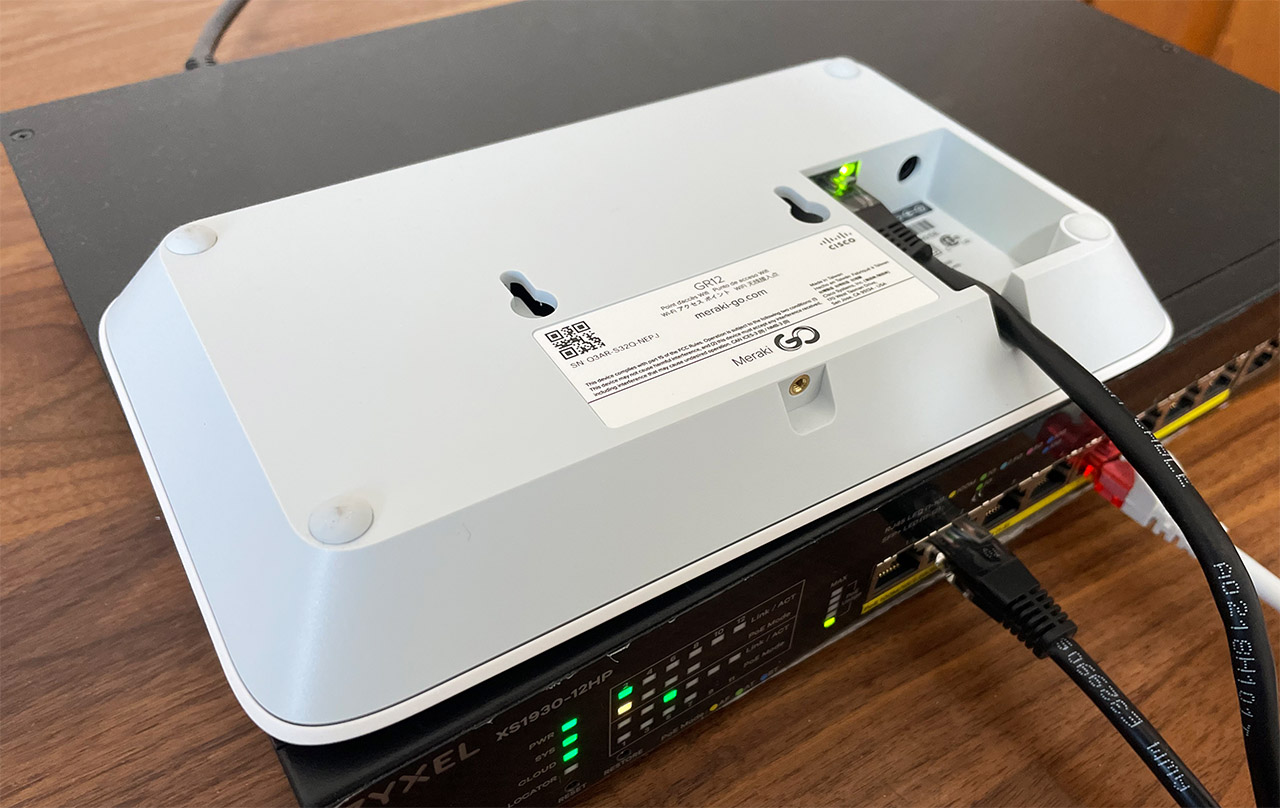
Internal Hardware (Meraki Go GR12 Teardown)
Before opening the case of the Meraki Go GR12 there’s good news and bad news. The good news is that there are no warranty voiding seals, the bad is that underneath the four silicone feet, Cisco decided to use unconventional screws. And although I had a healthy variety of Allen keys, none of them fit, so I had to just force my way through using a regular straight screwdriver. I mean it worked out in the end and after detaching the top cover, I could see the metallic piece for heat dissipation, while on the bottom part, there was the PCB.
At a closer inspection, I also saw three antennas, two for the 2.4GHz and 5GHz radio bands, while the third is for Bluetooth (you can see it on the right side of the PCB – it’s Bluetooth version 4.4). It’s a bit of a strange pattern since the PCB connects directly onto one antenna – after removing the board, I could see the second heat dissipating metallic piece attached to the bottom plastic part of the case.
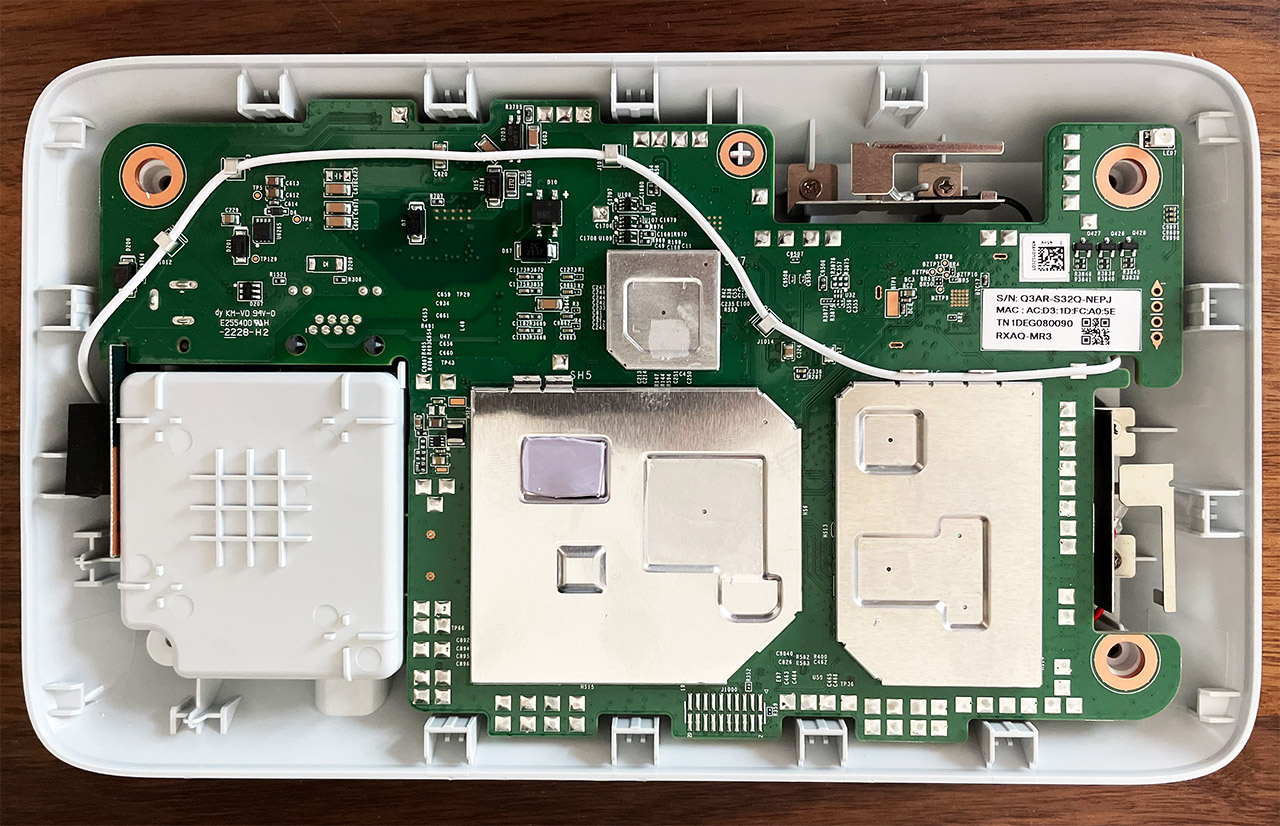
The main components were hidden underneath some aluminum heatsinks and, after removing them, I could identify the quad-core 1GHz Qualcomm IPQ6010 CPU, which is the same as on the EnGenius ECW220. There were also 256MB Spansion MS02G2 NAND flash storage memory, 1GB of RAM from SK Hynix (H5AN8G6NDJ), a Qualcomm QCA8081 switch chipset, an MG21 A020HI cellular gateway chip and a MPSN46 MP5496 power management solution.
As for WiFi, the Meraki Go GR12 uses the Qualcomm QCN5152 802.11a/n/ac/ax 2×2:2 chip for the 5GHz radio band and the Qualcomm QCN5121 802.11b/g/n/ax 2×2:2 chipset for the 2.4GHz radio band. I need to mention that the access point did not have any of that thermal glue paste thing nonsense, so kudos for that.
Meraki Go GR12 vs TP-Link EAP610 vs EnGenius ECW220S vs Ubiquiti U6-Pro
| Meraki Go GR12 | EnGenius ECW220S | TP-Link EAP610 | Ubiquiti U6-Pro | |
| CPU | quad-core 1GHz Qualcomm IPQ6010 | quad-core 1GHz Qualcomm IPQ6010 | quad-core 1.2GHz Qualcomm IPQ6000 | dual-core 1GHz Qualcomm IPQ5018 |
| RAM | 1GB SK Hynix (H5AN8G6NDJ) | 512MB Samsung (2x SEC 134 K4B4G16) | 256MB ESMT (M15T4G16256A) | 1GB 2x Kingston D5128ECMDPGJD |
| Storage | 256MB Spansion MS02G2 | 128MB MXIC X205107 MX30UF1G18AC-XKI | 128MB ESMT (F59D1G81MB) | 4GB Mouser Electronics (THGBMNG5D1LBAIL) + 8MB MXIC (25U6432F) |
| Switch | Qualcomm QCA8081 | Qualcomm QCA8072 | Realtek RTL8211F | Qualcomm IPQ5018 |
| 5GHz Radio | Qualcomm QCN5152 802.11a/n/ac/ax 2×2:2 | Qualcomm Atheros IPQ8072A (QCN5052) 802.11a/n/ac/ax 2×2:2 | Qualcomm QCN5052 802.11a/b/g/n/ac/ax 2×2:2 | Qualcomm QCN9024 802.11a/b/g/n/ac/ax 4×4:4/td> |
| 2.4GHz Radio | Qualcomm QCN5121 802.11b/g/n/ax 2×2:2 | Qualcomm Atheros IPQ8072A (QCN5021) 802.11b/g/n/ax 2×2:2 | Qualcomm QCN5052 802.11a/b/g/n/ac/ax 2×2:2 | Qualcomm IPQ5018 802.11b/g/n/ax 2×2:2 |
WiFi Features
The main WiFi 6 feature that’s supported by the Meraki Go GR12 is OFDMA which is a great way of handling very crowded networks, ensuring that more data is transmitted across multiple sub-carries (the channel is divided into smaller resource units) without using the entire channel for the transmission. As expected, OFDMA gets to be used only when there are compatible client devices and when the WiFi area is truly over-crowded, this being the last resort at having a reliable WiFi connection.
But is it ul and dl on both bands? Since there was no mention on their website, I checked out the user interface which has revealed that no such setting is available to the user. Unfortunately I don’t really have the means of testing if the support is actually there since that kind of equipment is tens of thousands of dollars, so hopefully it’s there. That’s the same as with BSS Coloring. This is a phenomenal feature which should help mitigate the co-channel interference and it’s not really something you see on inexpensive WiFi 6 access points.
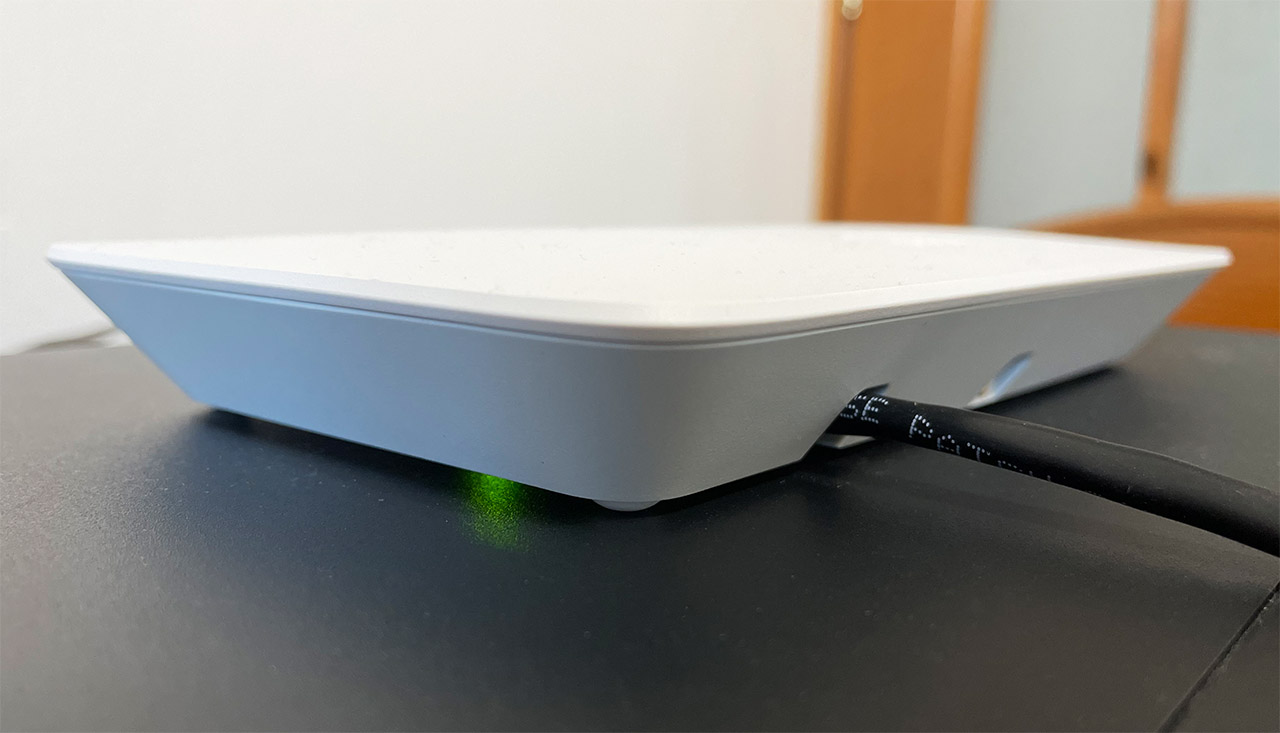
MU-MIMO and Beamforming are present and, as expected, you do need to use compatible client devices to see these features in action. Additionally, the Meraki Go GR12 can inter-connect with multiple other compatible access points to form a mesh network, but be aware that you can only use Meraki Go APs and they can’t be combined with Cisco Meraki access points. Lastly, I need to mention that the omni-directional antennas have a 5.6dBi gain for the 2.4GHz radio and a 5.3dBi gain for the 5GHz radio band.
Wireless Test (5GHz)
The Meraki Go GR12 has a single Ethernet port, so to create the client – server system, I had to connect the access point to a switch. As usual, I chose the Zyxel XS1930-12HP which was way overkill for this project, but it nicely powered on the GR12 (that, by the way, only needed 11W at the maximum load).
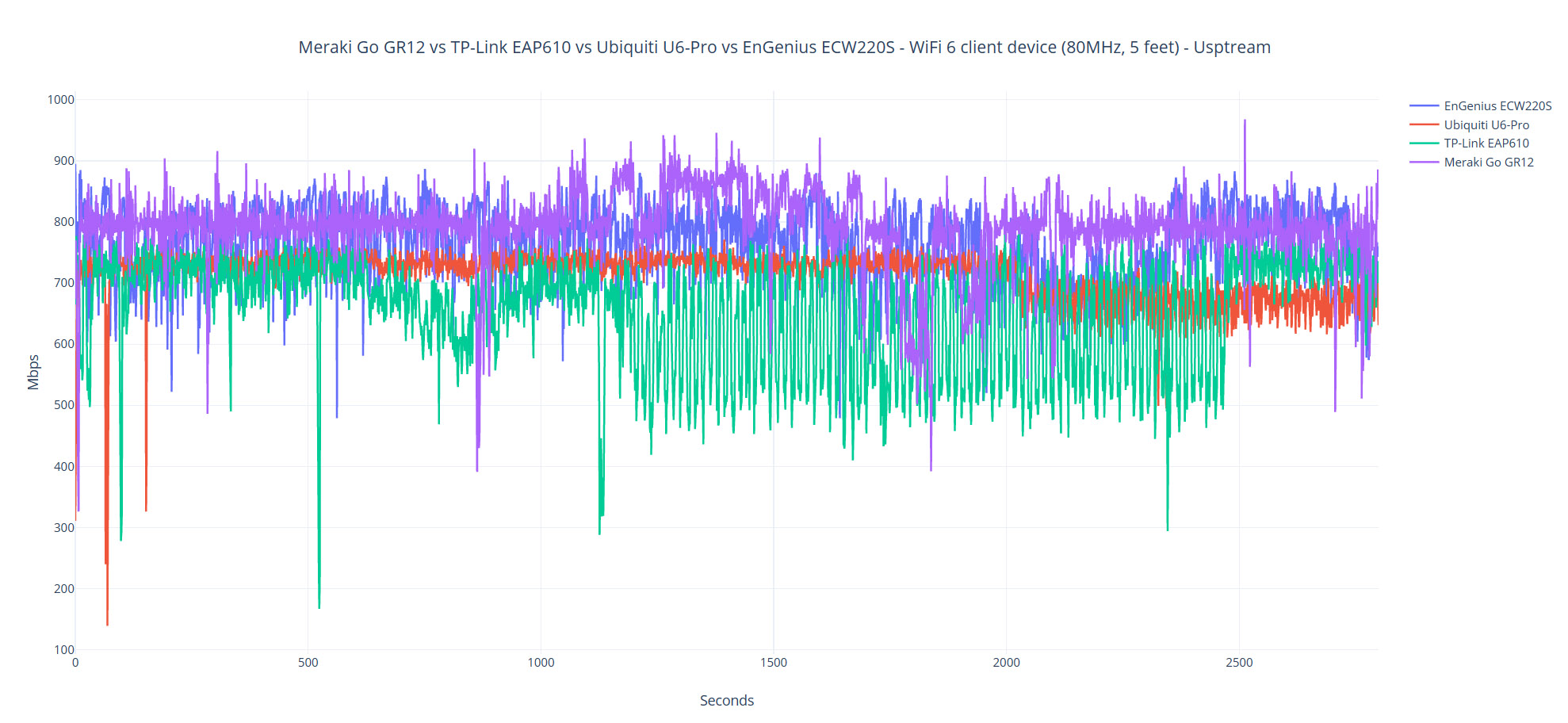
Afterwards, I connected a server PC and three client devices, one WiFi 6 (AX200) and two were WiFi 5 client devices. The latter two are still very much relevant considering that the overwhelming majority of people has devices that rely on this standard. The first series of tests were conducted while the WiFi 6 laptop (AX200) was connected to the 5GHz network (80MHz channel bandwidth – the interference was not that bad, so I could go all out). This way, I was able to measure an average of 791Mbps upstream and 438Mbps downstream at 5 feet, but do bear in mind that the attenuation was -44dB, which is not that great considering the distance.
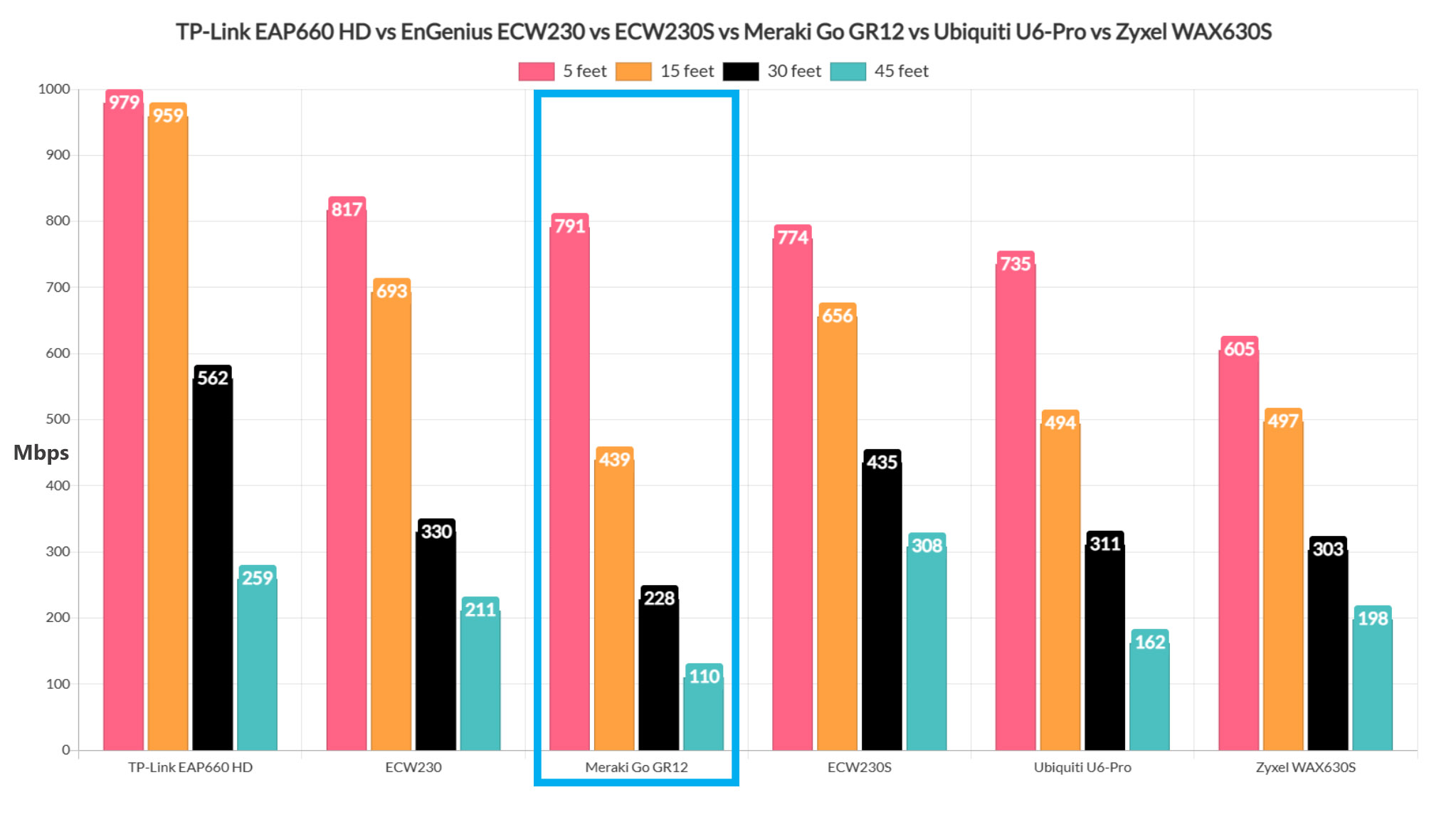
Moving a bit farther from the access point, I saw 439Mbps at 15 feet and 228Mbps at 30 feet (upstream), and the throughput was still very much usable at 45 feet, where upstream, it was 110Mbps, while downstream, it dropped to 45.9Mbps. At about 70 feet, the attenuation was already too much (-88dB) so the values that I got weren’t surprising: 11.5Mbps up and 2.2Mbps downstream. Moving to the WiFi 5 laptop equipped with an Intel 8265, the signal strength and attenuation is pretty much the same across the entire testing area, so I expected very similar results to the AX200.
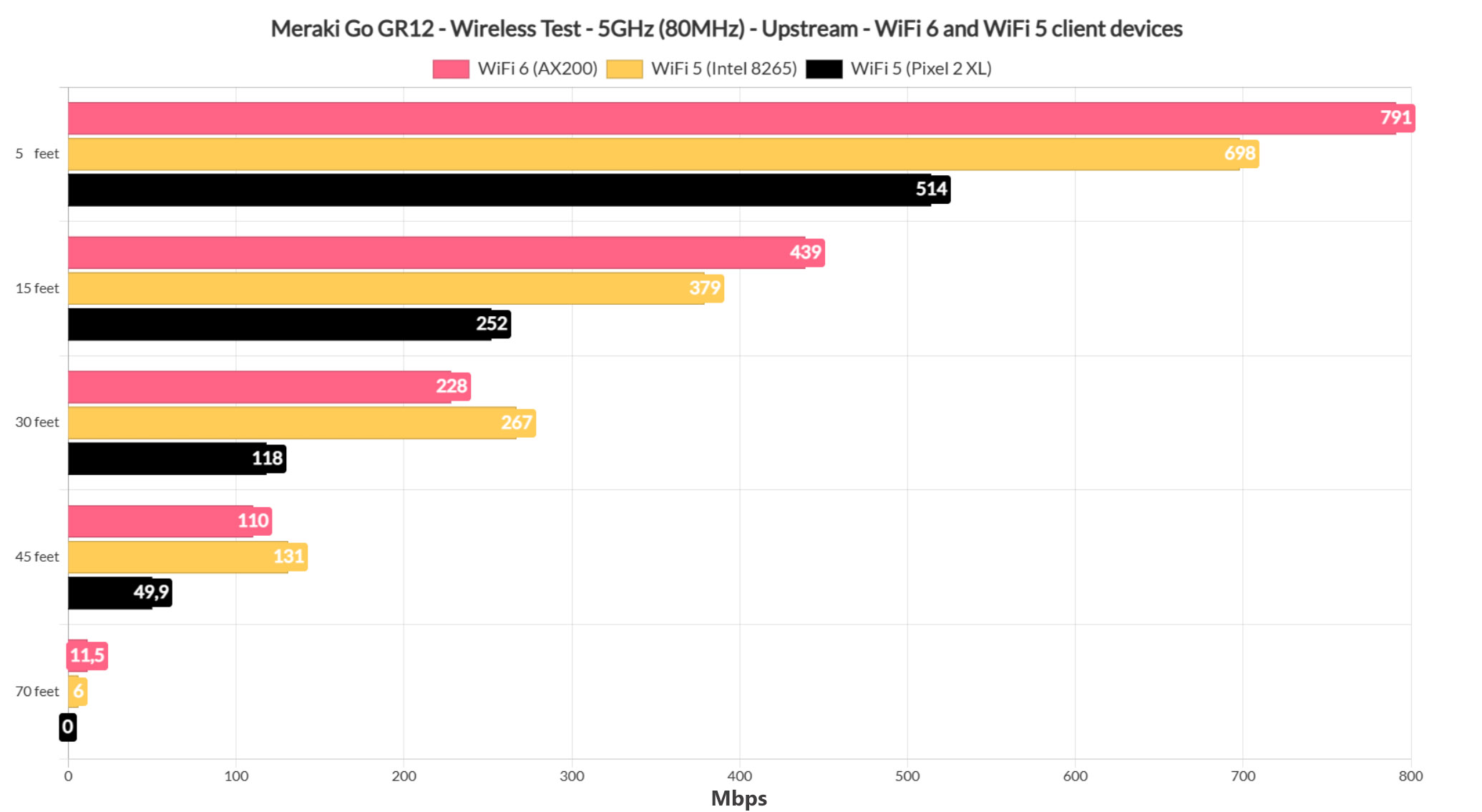
At 5 feet, it was not as good though, reaching 698Mbps up and 207Mbps downstream, but going a bit farther, the throughput got quite similar. At 30 feet, it was 267Mbps and at 45 feet, it was 131Mbps (both upstream).
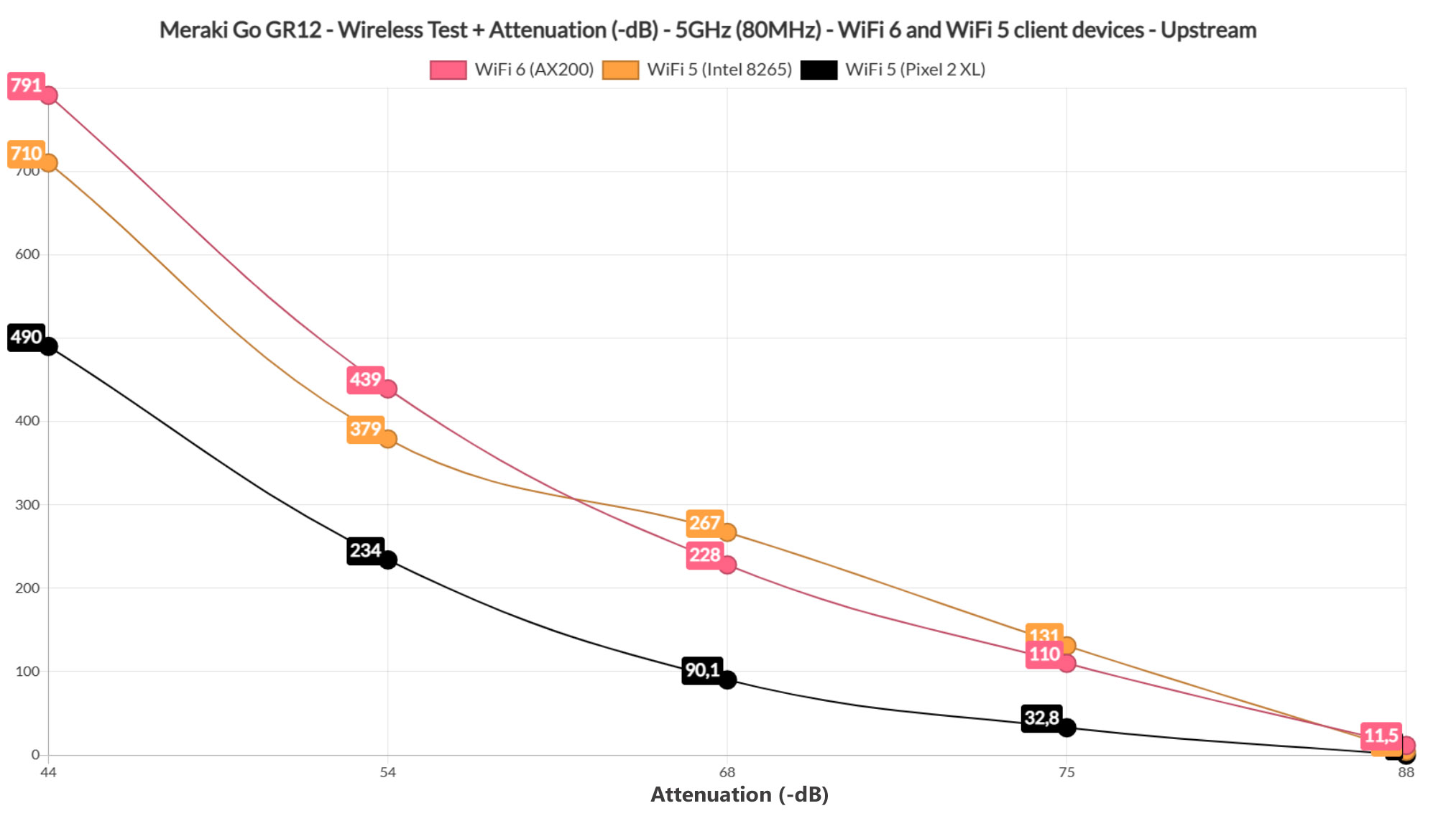
At 70 feet, things again kind of fell apart, considering that upstream, I measured 6Mbps and downstream it was only 1.6Mbps, so not really a good connection for any type of applications or services, unless very basic. The second WiFi 5 client device is the Pixel 2 XL which I keep on resurrecting for these articles – I need consistency between tests.
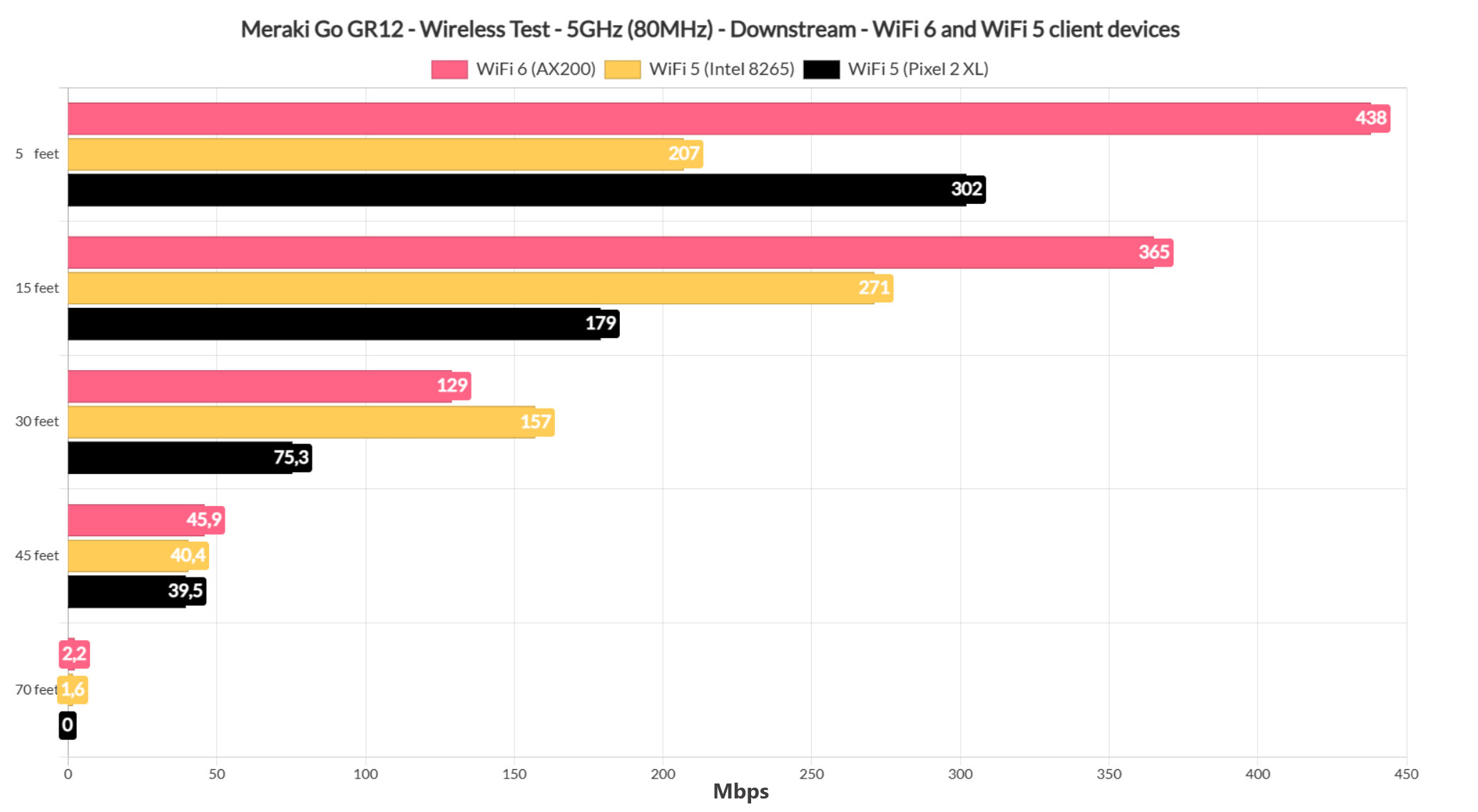
That being said, the Meraki Go GR12 didn’t really like the Pixel phone (or the other way around) because despite a fairly reasonable attenuation, I was only able to reach 45 feet – going farther immediately disconnected the client device.
Meraki Go GR12
-Pros
- WiFi 6 features (OFDMA, BSS Coloring and TWT)
- Decent wireless performance
- NAT and Bridge wireless address translation mode
- WPA3
- Support for Mesh and PoE
Cons
- Some awkwardness when installing the access point (software-wise)
- The advanced features are not really that advanced
- No actual platform controller for multiple types of Meraki Go devices

Mark is a graduate in Computer Science, having gathered valuable experience over the years working in IT as a programmer. Mark is also the main tech writer for MBReviews.com, covering not only his passion, the networking devices, but also other cool electronic gadgets that you may find useful for your every day life.

